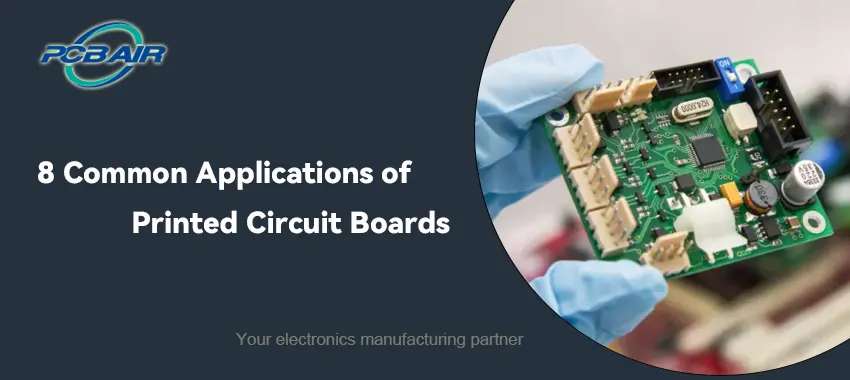8 Common Applications of Printed Circuit Boards
Electronics, from smartphones to kitchen appliances, are integral to our everyday lives. At the core of these devices is a PCB, serving as the foundation for most electronic products. PCBs come in numerous configurations to serve different functions. As the electronics sector advances, the application of PCBs broadens, spanning nearly every industry and continually branching into new fields.
So what is a PCB?
PCBs are the connectors for electronic components in the devices we use daily across multiple industries. These boards, made from non-conductive materials, feature etched copper lines, pads, and other elements that link the electronic parts within a product. Components like capacitors and resistors are soldered onto these boards.
The presence of PCBs in electronics is prevalent, and they come in several forms. PCBs may be single-sided, double-sided, or multilayered. Additionally, they can be designed as rigid, flexible, or a combination of both.
What Are Common Uses for PCBs?
1. Medical Devices

PCBs are crucial in the healthcare industry, appearing in devices from medical imaging systems like ultrasonic and CT scanners to vital monitoring technologies and internal devices like pacemakers. These applications typically use HDI PCBs, which are compact and adhere to strict sanitation standards.
PCBs are very important in the healthcare industry, appearing in devices from medical imaging systems like ultrasonic and CT scanners to vital monitoring technologies and internal devices like pacemakers.
2. Consumer Electronics

Smartphones, computers, and IoT devices like smart speakers often need PCBs to function. Household electronics, including microwaves and refrigerators, also depend on PCBs.
As more devices gain IoT compatibility, their need for PCBs increases. Devices like smartphones and home assistants require small PCBs packed with numerous connections to meet their complex demands.
3. Automotive Components

Modern cars integrate more electronics than ever before, far beyond the basic functions of the past like headlight switches and windshield wipers. Today, cars incorporate advanced electronic circuits using PCBs designed to handle high-frequency signals. These are essential for sensor applications such as radar systems used in collision avoidance, blind spot monitoring, and adaptive cruise control, previously exclusive to military vehicles but now standard in many cars.
4. LEDs

Light-emitting diodes, or LEDs, have become a preferred choice for lighting in homes, commercial spaces, and various industries such as automotive, medical, and computer technology due to their energy efficiency, longevity, and compact size.
PCBs in LED systems primarily manage heat dissipation to extend the lifespan of the LEDs. High temperatures can shorten an LED’s life, so PCBs for these applications are often made with aluminum, a material that efficiently conducts heat, reducing the need for additional cooling components and allowing for more streamlined designs.
5. Aerospace Components

Aerospace electronics share many requirements with automotive technologies but often face more extreme conditions. PCBs find use in aircraft, space shuttles, satellites, and radio communication systems.
The production of aerospace PCBs demands materials that can endure severe vibration, drastic temperature changes, and other demanding conditions. Some need to function in space, requiring exceptional durability. Lightweight materials like aluminum are advantageous for aerospace applications, and anodizing aluminum enhances its oxidation resistance.
6. Industrial Equipment

From heavy-duty machinery like drills and presses to sophisticated control systems, industrial equipment depends on PCBs. You find them regulating pressure, temperature, and other variables during manufacturing processes. PCBs are also essential for the growing field of industrial automation, improving efficiency and reducing human error.
Industrial environments demand different types of PCBs. Some must withstand the constant vibrations of machinery, extreme temperatures, high-voltage currents, or exposure to harsh chemicals. To meet these needs, manufacturers employ various solutions: PCBs made from heat-resistant materials, through-hole technology, rigid-flex PCBs, and PCBs with thicker copper layers.
7. Maritime Applications

Marine vessels and systems, from small boats to large cargo ships and submarines, depend on PCBs for operation, including communication and navigation equipment. PCBs in these settings must endure harsh conditions. High reliability is key to ensuring the safety of crews and passengers.
8. Safety and Security Equipment

PCBs are integral to the functionality of security systems in homes, businesses, and government facilities. They are more critical to our safety than often recognized.
The suitability of a PCB depends on its use. All PCBs for safety and security must be dependable, as these systems need to work without fail. Some devices are used outdoors and require PCBs that can handle environmental exposures.
Need Further Support?
If you’re unsure about the right PCB for your product or don’t know where to begin, feel free to contact our expert team. Regardless of the type of PCB your company requires—be it double-sided, single-sided, SMT, through-hole, or mixed assembly, we deliver cost-effective solutions.


